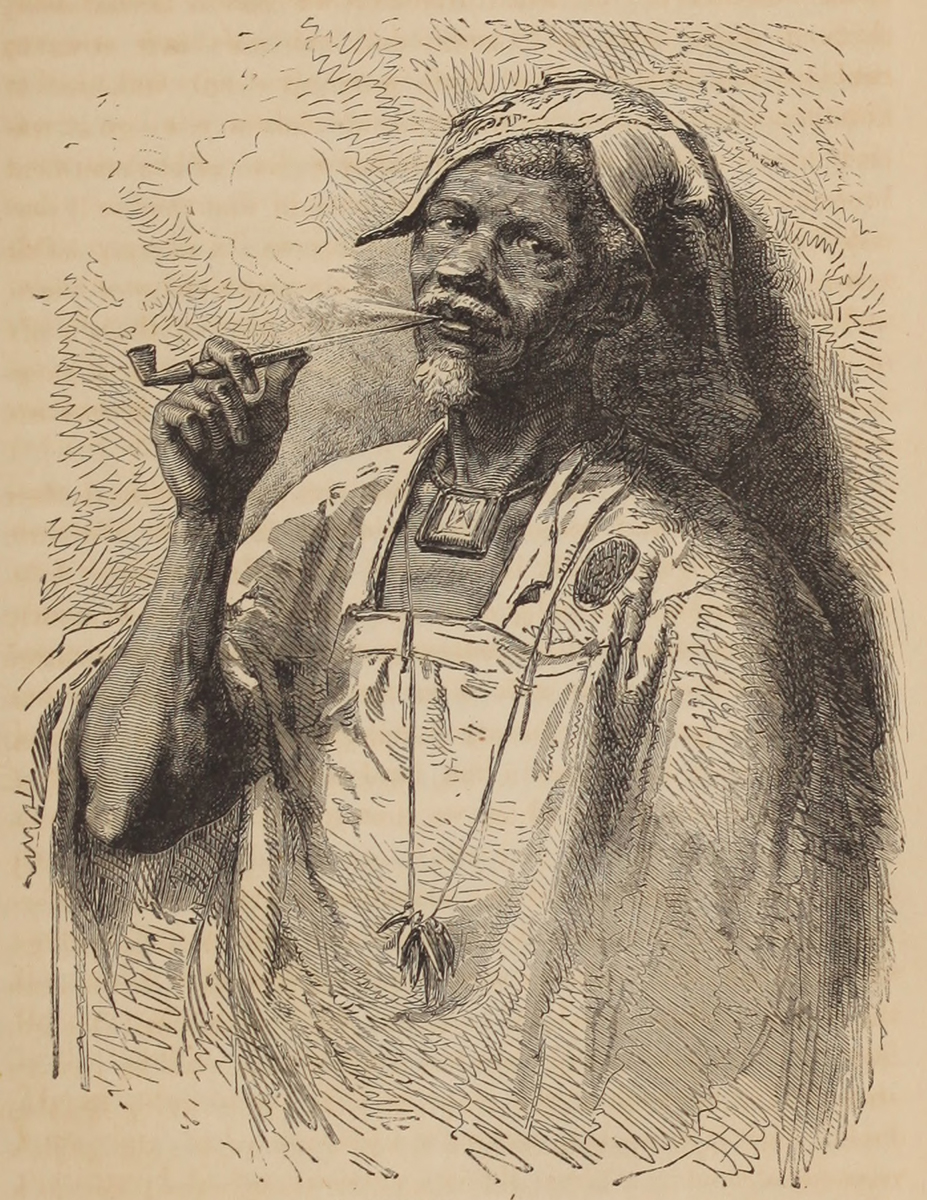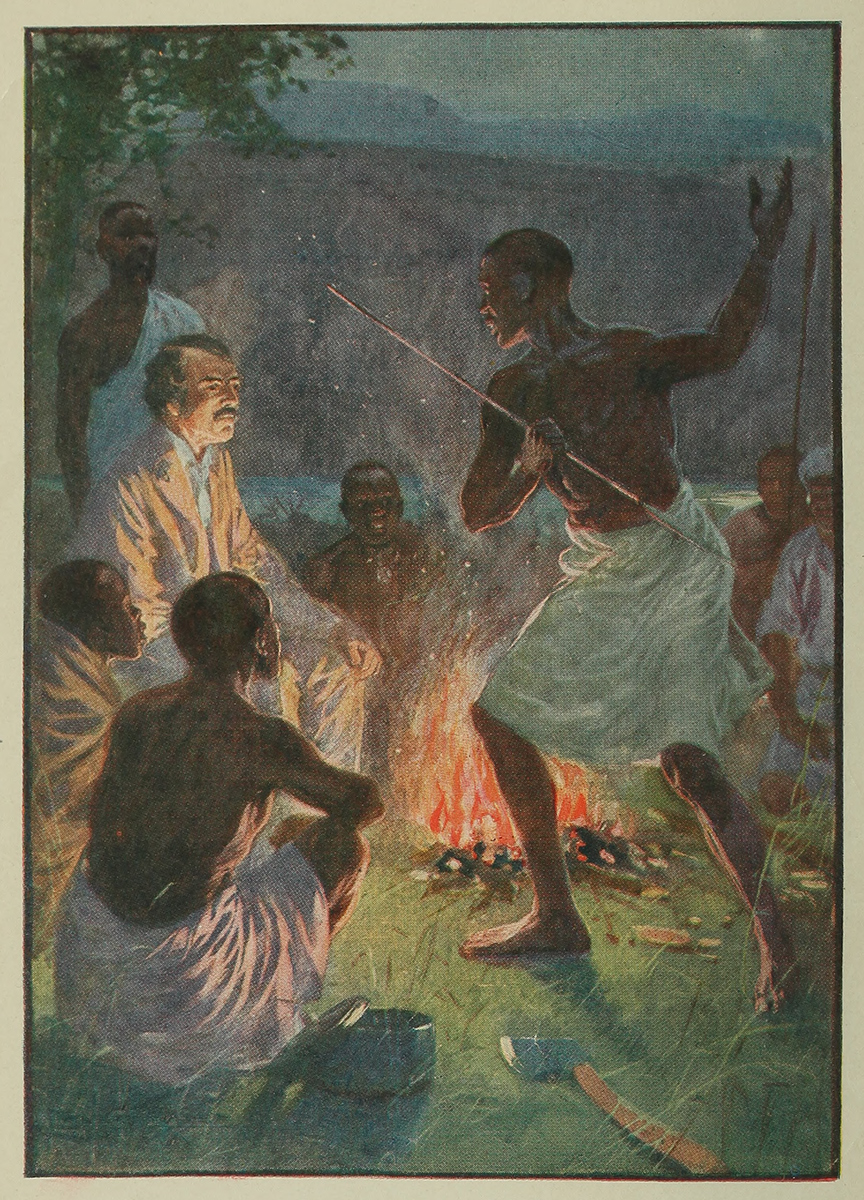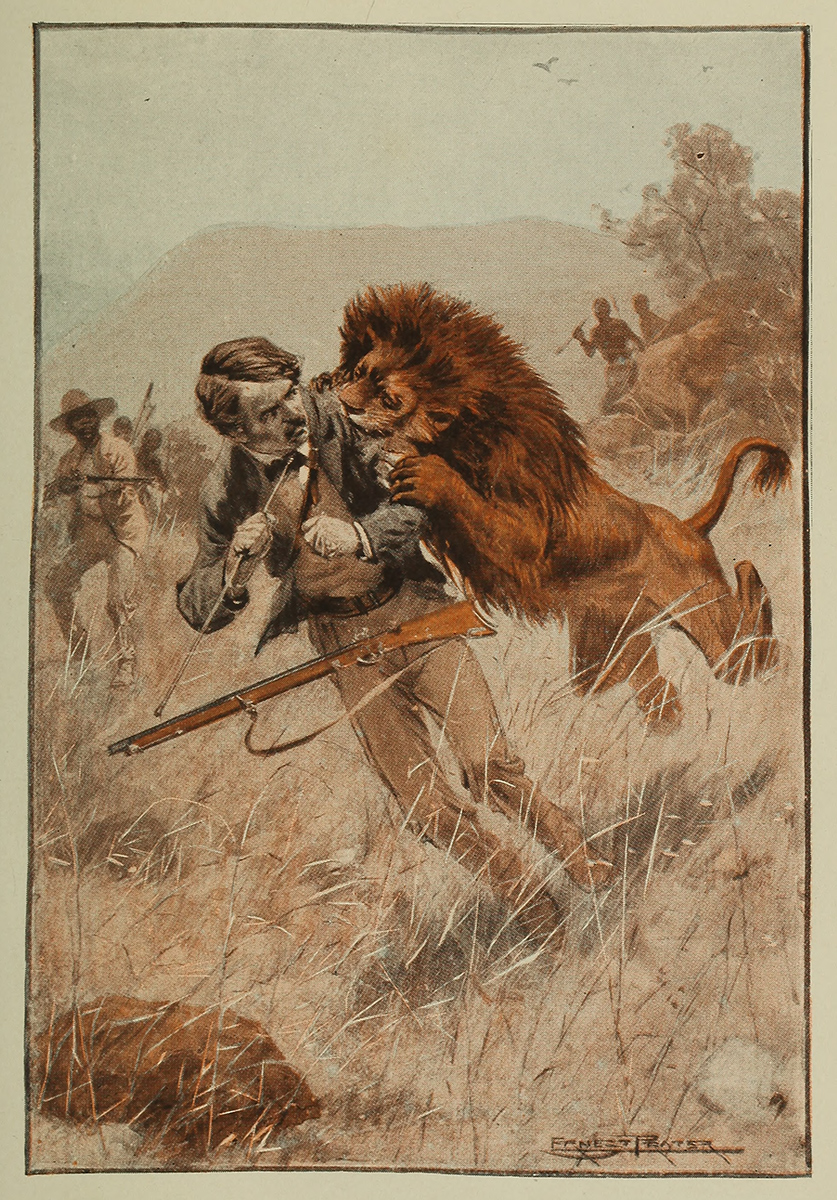Digital Humanities, Exploration Literature, and Missionary Travels
Cite (MLA): Livingstone, Justin D. "Digital Humanities, Exploration Literature, and Missionary Travels." Adrian S. Wisnicki, ed. In Livingstone's Missionary Travels Manuscript. Justin D. Livingstone and Adrian S. Wisnicki, dirs. Livingstone Online. Adrian S. Wisnicki and Megan Ward, dirs. 2019. Web. http://livingstoneonline.org/uuid/node/60f1557b-6855-48dc-9af3-0dc8dfb3d93a.
This essay investigates the advantages that digital technologies have brought to the task of editing the Missionary Travels manuscript (1857). The essay begins by discussing the critical value of digital remediation for a “materialist” approach to the record of exploration (and specifically to the manuscript of Missionary Travels) and concludes by extending connections between disciplinary developments in travel writing studies and the practice of textual editing.
Introduction Top ⤴
This edition focuses on a single Livingstone document: the literary manuscript of his most celebrated work, Missionary Travels and Researches in South Africa (1857). By dealing with a document intended for publication, this edition departs from others on Livingstone Online whose remit is primarily in-transit writings produced in the field, such as diaries, journals, and correspondence. This edition thus sets out to address a later phase of the production of the literary record of British expeditions in Africa: the processed narrative, prepared for circulation in print.

Marked proof engraving of Reception of the Mission by Shinte. Illustration for Missionary Travels (Livingstone 1857aa:opposite 291). Copyright National Library of Scotland and Dr. Neil Imray Livingstone Wilson (as relevant). Creative Commons Share-alike 2.5 UK: Scotland. As part of preparing the manuscript for print, Livingstone also worked with his publisher John Murray on developing the illustrations that would accompany the narrative. This engraving shows annotations from Livingstone in pencil, including a request for "many more rings on the legs & arms of Shinte." A note in ink by another hand (possibly John Murray), in turn, instructs the engraver Josiah Wood Whymper to implement the requisite changes. In the published version of the engraving (Livingstone 1857aa:opposite 291), Shinte thus appears with considerably more rings on his arms and legs.
While such processed narratives drew on earlier phases of travel records, they were often crafted with a wider awareness of public readership and the literary marketplace. The holograph of Missionary Travels is a working document, showing extensive authorial revision and editorial correction; it is a manuscript with intermediate status, occupying the space between initial records and the final published volume (although closer to the latter). In taking such a manuscript as its object, this edition has been developed to disclose the later stages of the passage to print, whereby the documentation of exploration is shaped into a narrative designed for public consumption.
This piece considers the possibilities afforded by digital technologies for a manuscript-based edition of a major nineteenth-century travelogue. The essay argues for the critical benefits of digital remediation in facilitating engagement with the document’s features at a granular level. It also situates the present edition in the context of a “materialist turn” in scholarship on the literature of exploration. Ultimately, the essay suggests that by capturing Livingstone’s inscriptive practices in detail and the numerous editorial interventions made by others, Livingstone’s Missionary Travels Manuscript (1857): A Critical Edition extends connections between travel writing studies and the practice of textual editing.
The Value of Digital Formats Top ⤴
Over the past two decades, ambitious editorial projects have increasingly made their way into the digital realm. While print editions, which generally aim to produce stable versions of texts, continue to have considerable value for both general readers and scholarly discourse, online formats present new scope for editorial practice. From the earliest formations, a chief attraction of digital editions has been the extent of the material that they can incorporate. Rather than synthesising differences across textual variants in order to produce an “ideal” text, for instance, digital editions might instead include each iteration of the book or document in question (Price 2008).
Such projects can avoid the selectivity that inheres in bibliographic criticism by taking advantage of the “unbound” nature of the web (Fyfe 2008). It is such freedom from the spatial constraints of the physical book that has resulted in large-scale digital projects that are as much archives as editions in their aspiration to provide complete documentation for particular authors (for discussion of this terminology and its limitations, see Price 2009 and Mussell 2012:123-34).
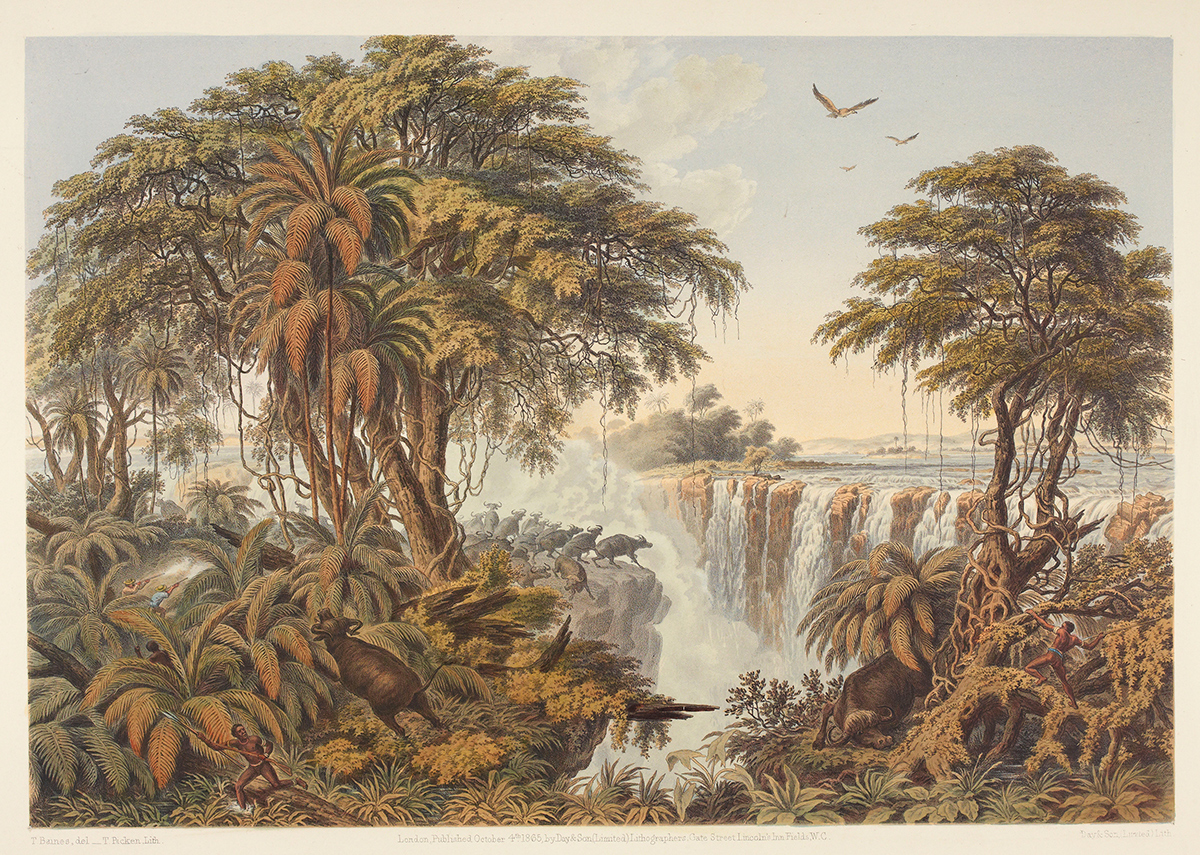
Herd of Buffaloes Driven to the Edge of the Chasm. Illustration from Thomas Baines, The Victoria Falls, Zambesi River, Sketched on the Spot (London: Day & Son, 1865), plate 6. Copyright National Library of Scotland and Dr. Neil Imray Livingstone Wilson (as relevant). Creative Commons Share-alike 2.5 UK: Scotland. In addition to thousands of manuscripts, Livingstone Online also publishes images of numerous contextual items, such as this one. These items include commemorative objects directly connected to Livingstone as well as artefacts of wider historical significance, which illuminate nineteenth-century European perspectives on central and southern Africa. For instance, Baines' paintings of Victoria Falls, including the one above, were among the first pictorial studies of this celebrated geographical feature. By providing access to these paintings alongside expeditionary records by others, Livingstone Online situates Baines' work as part of the wider culture of exploration while also providing insight into the aesthetic modes that contemporary artists adopted to represent the geographical contexts of Livingstone’s travels.
Although the present edition addresses a single text, the inclusive potential of the digital format has facilitated editorial aspirations that could not have been realised in print. At over 1100 pages, the Missionary Travels manuscript would itself have tested the limits of the single volume form. An attempt to incorporate the published book as a parallel text, moreover, would have resulted in an unwieldy tome, if it were even possible to produce at all. On Livingstone Online, however, there are no such limitations – and this edition is able to avail of that freedom.
Publishing as part of Livingstone Online has the added advantage of ensuring that the edition’s material is also embedded in the site’s wider corpus of Livingstone documents. This of course facilitates connection to the author’s written output from across his long career; as part of an extensive online collection, the present edition is contextualised amongst other critical editions and open access materials, taking its place in the largest single-author digital collection of travel documents from mid-nineteenth-century sub-Saharan Africa.
Digital collections clearly offer considerable scope for inclusive documentation and detailed contextualisation. Beyond such advantages, digital technologies also have the capacity to deepen engagement with “the nature of textuality” and its material dimensions (Price 2008). The latest phase of the Livingstone Spectral Imaging Project compellingly demonstrates this point in using advanced imaging to uncover new information about, for example, the handling of and environmental impact on the actual manuscript pages of Livingstone’s 1870 Field Diary. Such technology reveals features of documents which cannot be seen by the naked eye and which would otherwise remain unstudied (Wisnicki and Ward 2017).
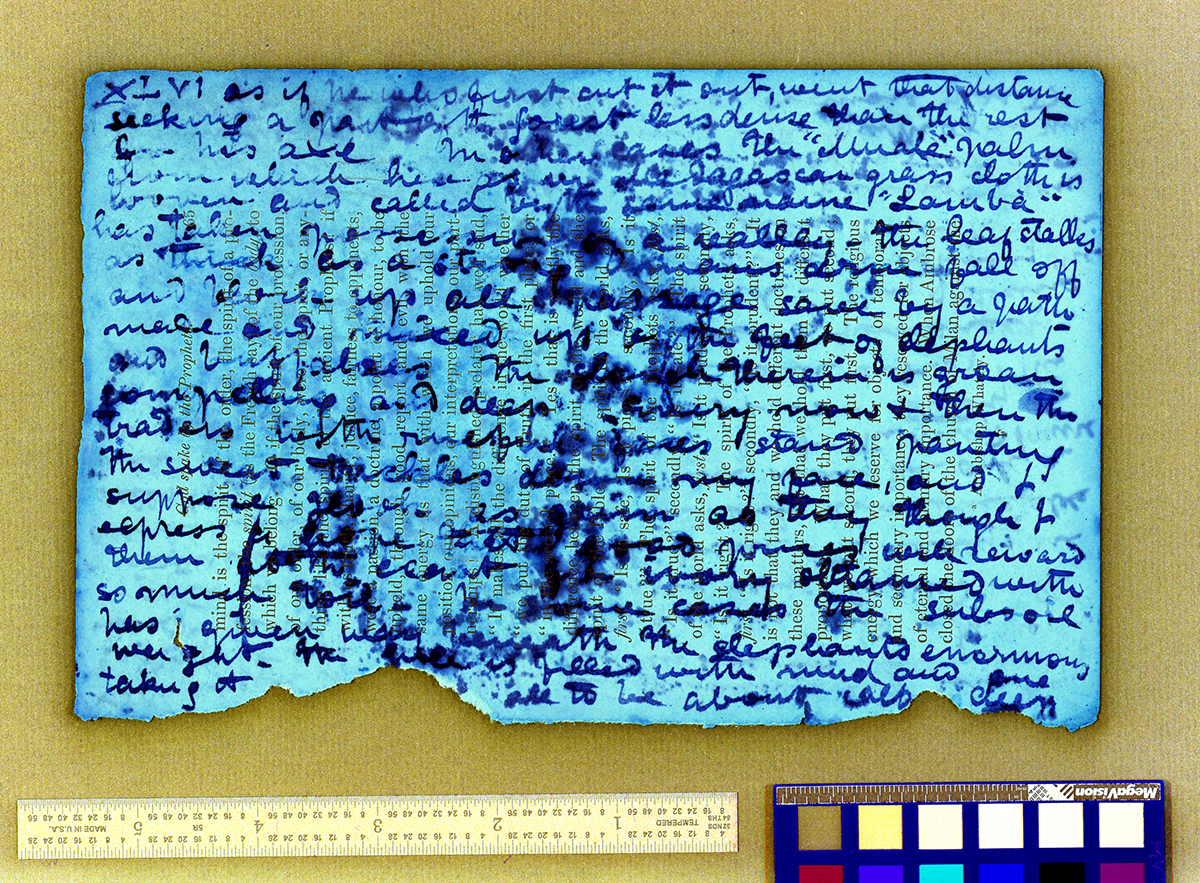
A spectral image of a page of the 1870 Field Diary (Livingstone 1870:XLVI spectral_ratio). Copyright National Library of Scotland and Dr. Neil Imray Livingstone Wilson (as relevant). Creative Commons Attribution-NonCommercial 3.0 Unported. The image processing here not only helps clarify Livingstone's text, but also foregrounds material features such as saturation by an unconfirmed substance (probably water).
Even where the application of technology is less ambitious, projects that integrate high quality facsimiles of original documents, such as Jane Austen’s Fiction Manuscripts or The Shelley-Godwin Archive, can prompt fruitful considerations of materiality. Such projects successfully demonstrate that digital objects are able to enhance the scrutiny of the page, to prompt renewed attention both to medium and to those paratextual elements that are constitutive of meaning (Thomas 2010; cf. Wisnicki and Ward 2017).
These digitisation projects, however, also acknowledge that facsimiles should not be taken as replacements for manuscripts themselves, as if they were mimetic reproductions. The size, weight, and feel of the physical objects are part of their “signifying structures” and are inevitably lost in conversion to digital media; indeed, as such projects recognise, remediation is always a form of transformation (Sutherland 2009:20, Kichuk 2007:296-97).
Digital Remediation of the Missionary Travels Manuscript Top ⤴
The present edition avails of the considerable advantages of digital remediation. The ability to magnify manuscript features has enabled a much closer examination of particular details than would have been possible in consulting the physical document unaided. The enhanced examination facilitated by high quality images has allowed the project team to successfully read an extensive range of cancelled text – including lengthy excised passages – that would otherwise have been simply illegible. The opportunity to magnify high-resolution images has likewise been crucial in detecting and deciphering overwriting, some of the most impenetrable text in the manuscript.
![Image of Livingstone's Map of Barotseland (Livingstone 1851:[1]), detail. Image from SOAS Library, University of London. Image copyright Council for World Mission. Used by permission for private study, educational or research purposes only. Please contact SOAS Archives & Special Collections on docenquiry@soas.ac.uk for permission to use this material for any other purpose. As relevant, copyright Dr. Neil Imray Livingstone Wilson. Creative Commons Attribution-NonCommercial 3.0 Unported (https://creativecommons.org/licenses/by-nc/3.0/). Image of Livingstone's Map of Barotseland (Livingstone 1851:[1]), detail. Image from SOAS Library, University of London. Image copyright Council for World Mission. Used by permission for private study, educational or research purposes only. Please contact SOAS Archives & Special Collections on docenquiry@soas.ac.uk for permission to use this material for any other purpose. As relevant, copyright Dr. Neil Imray Livingstone Wilson. Creative Commons Attribution-NonCommercial 3.0 Unported (https://creativecommons.org/licenses/by-nc/3.0/).](/sites/default/files/in-his-own-words/missionary-travels-manuscript/digital-humanities-exploration-literature-and-missionary-travels/liv_002680_0001-article-crop.jpg)
Image of Livingstone's Map of Barotseland (Livingstone 1851:[1]), detail. Image from SOAS Library, University of London. Image copyright Council for World Mission. Used by permission for private study, educational or research purposes only. Please contact SOAS Archives & Special Collections on [email protected] for permission to use this material for any other purpose. As relevant, copyright Dr. Neil Imray Livingstone Wilson. Creative Commons Attribution-NonCommercial 3.0 Unported. Digital publication can facilitate examination of Livingstone's hand-drawn maps as well as his written records. The enlarged section of the map shown here details Livingstone's cartographic efforts to represent part of Barotseland, the historical homeland of the Lozi people. In the nineteenth-century, these lands were occupied by the Makololo; Livingstone began his transcontinental journey from the Makololo capital of Linyanti (shown at left in this section).
Determining details like these could seem mundane, but the collective result of this digitally-enhanced examination is that manuscript revision practices are captured in a much more complete manner than has hitherto been achieved in work on narratives of exploration. These particulars provide a cumulative picture of the editorial process, the interventions of the individuals it involved, and the patterns of redaction that shaped the text during its composition. Some revisions are of course simply stylistic, but others (as the edition explores elsewhere) reveal wider concerns of literary propriety and public reception, which influenced what Livingstone and his editors felt could and could not be said in print in Victorian Britain.
Such fine-grained attention to detail is captured in the edition’s encoded transcriptions, which attain a high degree of fidelity to Livingstone’s manuscripts (see Textual Principles and Editorial Decisions). Indeed, in an effort to reduce the distance between physical object and digital surrogate, the onscreen rendering (made possible by the underlying encoding) mirrors the material characteristics of the original pages and approximates towards their layout. The transcriptions, which also integrate explanatory notes as tooltips, are thus designed to enable users to navigate and better understand the complexities of a heavily corrected and multi-hand document.
![Image of a page from the Missionary Travels manuscript accompanied by transcription, as displayed in the Livingstone Online manuscript viewer (Livingstone 1857cc:[13]). Copyright National Library of Scotland and Dr. Neil Imray Livingstone Wilson (as relevant). Creative Commons Share-alike 2.5 UK: Scotland (https://creativecommons.org/licenses/by-nc-sa/2.5/scotland/). Image of a page from the Missionary Travels manuscript accompanied by transcription, as displayed in the Livingstone Online manuscript viewer (Livingstone 1857cc:[13]). Copyright National Library of Scotland and Dr. Neil Imray Livingstone Wilson (as relevant). Creative Commons Share-alike 2.5 UK: Scotland (https://creativecommons.org/licenses/by-nc-sa/2.5/scotland/).](/sites/default/files/in-his-own-words/missionary-travels-manuscript/digital-humanities-exploration-literature-and-missionary-travels/liv_000100_0013_screenshot-article.jpg)
Image of a page from the Missionary Travels manuscript accompanied by transcription, as displayed in the Livingstone Online manuscript viewer (Livingstone 1857cc:[13]). Copyright National Library of Scotland and Dr. Neil Imray Livingstone Wilson (as relevant). Creative Commons Share-alike 2.5 UK: Scotland. This screenshot highlights the level of detail in which the digital transcriptions included in the present edition capture key features of the original Missionary Travels manuscript, including deletions, overwriting, textual additions, and marginal annotations.
At the same time, the opportunity for close analysis is passed directly onto users who are given access to images of the original documents themselves. Livingstone Online’s manuscript viewer brings the added value of enabling users to engage in their own enhanced inspection of the author’s script, passages written by others (notably by Livingstone’s brother Charles Livingstone), and the range of annotation and editorial markup. The format of this edition, with transcriptions and facsimiles displayed side-by-side, allows readers to benefit from the project team’s critical work while also making their own interpretations of Livingstone’s manuscript.
In fact, this edition uses its digital platform to present its material in ways that facilitate use by scholars and others. For instance, Livingstone Online’s multi-text viewer enables close comparative work of different versions of Livingstone’s writings. In the case of Missionary Travels, users can view transcriptions of the holograph alongside the 1857 published version of the text, scrutinising for themselves the transformations that occurred between manuscript and book. As with Livingstone Online more widely, this edition is designed to make effective use of the possibilities for access and scholarship that are available in the digital environment.
Materialist Approaches to the Travel Record Top ⤴
In its close attention to the physical document, the present edition also pursues what has been described as a “materialist” approach to the literature of exploration (Mayhew 2007, Withers and Keighren 2011). Accordingly, the edition takes as its foundation the importance of interrogating books as material objects, of attending closely to their physicality, their conditions of production, and the procedures by which they were prepared for publication.
Materialist readings insist that books are “more than simply their final printed content” and that they should be read as the result of “assemblages of practices” (Withers and Keighren 2011:561-62). In other words, the processes of authorial revision, editorial redaction, and the wider mediating influence of the publishing industry were critical in shaping expeditionary narratives prior to their dissemination to the reading public.
| (Left; top in mobile) Sechele, Chief of the Bakwains. Illustration from James E. Ritchie, The Pictorial Edition of the Life and Discoveries of David Livingstone, 2 vols (London and Edinburgh: A. Fullarton & Co., 1856-1879), 1:272. Copyright Adrian S. Wisnicki. Creative Commons Attribution-NonCommercial 3.0 Unported. (Right; bottom) Sebituane. Illustration from J. E. Chambliss, The Life and Labors of David Livingstone, LL.D., D.C.L. (Philadelphia, Boston, and Cincinnati: Hubbard Bros., 1875), 81. Courtesy of the Internet Archive. These sketches show artists' impressions of two African individuals linked to Livingstone's first period in southern and central Africa (1841-56). Sechele, chief of the BaKwena, supported Livingstone's residence amongst the BaTswana groups and facilitated his early expeditions to Lake Ngami and beyond. Although Livingstone only briefly met Sebitwane, chief of the Makololo, his son and heir Sekeletu served as a major patron of the transcontinental expedition and equipped Livingstone with supplies as well as a retinue of guides and porters. The illustration of Sechele resembles contemporary photographs (see, e.g., Anon n.d.), but it is not known how closely, if at all, the representation of Sebitwane relates to the appearance of the real individual. By including these illustrations, the present edition seeks to complicate critical discussions of Missionary Travels that tend to focus on Livingstone, while also underscoring gaps in the historical record that continue to remain as a result of limitations in the source materials. |
Materialist approaches thus acknowledge the contingency of the travel record, and the extent to which published texts were often highly negotiated documents. This process of negotiation began in the field itself, where the information that travelers were able to record was mediated by guides and local informants, and continued at home through the individuals and institutions that ultimately came to shape published travelogues.
In the present case, by disclosing the mutability of the text, a materialist approach clarifies the process of constructing nineteenth-century knowledge about the non-western world. While works of geographical travel were often marketed as authoritative eyewitness accounts of distant regions, they were ultimately processed narratives whose final forms were determined by interactions between authors, editors, and publishers.
The “materialist turn” is now well established in studies of the literary culture of exploration (Withers and Keighren 2011:562). Relevant scholarship reaches back to Roy Bridges’ work on east African travel records, which urged greater engagement with unpublished “first-stage” field notes and cautioned against over-reliance on published accounts (1987:179-80). In various essays, Bridges also outlined a three-stage record-making process that consisted of initial notes, the notes rewritten as a “coherent journal,” and then finally the journal revised into the published narrative (Bridges 1987, 1998:72).
![Image of a page from Copies of Ledger E of the Publisher John Murray: Production and Sales Details for David Livingstone's Missionary Travels (1857-1862:[1]). Copyright National Library of Scotland . Creative Commons Share-alike 2.5 UK: Scotland (https://creativecommons.org/licenses/by-nc-sa/2.5/scotland/). Image of a page from Copies of Ledger E of the Publisher John Murray: Production and Sales Details for David Livingstone's Missionary Travels (1857-1862:[1]). Copyright National Library of Scotland. Creative Commons Share-alike 2.5 UK: Scotland (https://creativecommons.org/licenses/by-nc-sa/2.5/scotland/).](/sites/default/files/in-his-own-words/missionary-travels-manuscript/digital-humanities-exploration-literature-and-missionary-travels/liv_014048_0001-article-crop-1200.jpg)
Image of a page from Copies of Ledger E of the Publisher John Murray: Production and Sales Details for David Livingstone's Missionary Travels (1857-1862:[1]). Copyright National Library of Scotland. Creative Commons Share-alike 2.5 UK: Scotland. John Murray’s business records reveal the processes of production involved in preparing narratives of exploration for publication. This ledger page lists the individuals and establishments employed by Murray to work on Missionary Travels and notes the sums paid for tasks including drawing, engraving, preparing maps, revising manuscript, advertising, and printing and binding copies. Such records highlight the commercial considerations of Victorian publishers, who were concerned not only with disseminating geographical knowledge, but also with producing marketable commodities that would sell widely.
This perceptive outline has been refined in further research, as scholars have investigated the dynamics of these phases in more detail, particularly the latter stages, in which documents evolved into publishable form. Specifically, the final transition from journal to print has been unravelled as a multi-stage process, consisting of draft manuscripts, author-publisher correspondence, and corrected proofs (see MacLaren 1994, 2003, Finkelstein 2003, Bell 2013).
Recent scholarship has likewise disclosed the complications of the transition from notes to journals – from first impressions to later reflections. Scripting such documents was not always a simple case of expanding on the partial jottings of notebooks; rather, preparing journals provided opportunities to revise, reorganize, and reconceptualize earlier writings, a process that might elide discrepancies and lend coherence to the expeditionary record, but which could also introduce new tensions (Wisnicki 2013, 2017).
Digital Editing and the Documentation of Expeditions Top ⤴
Taken as a whole, Livingstone Online extends critical insight into the documentation of exploration from its first to final phase by foregrounding the material complexities inherent in the manuscript record. The letters and diaries published by the site, particularly through multi-spectral critical editions, illuminate the early stages by examining Livingstone’s in-field practices of composition and redaction.
Those perspectives are complemented in turn by the present edition’s dissection of the subsequent steps in the journey to print. With the addition of the Missionary Travels manuscript, users will now be able to track the production of travel records end to end, from notes in the field to printed narratives. Indeed, by showcasing Livingstone’s practices of inscription as he prepared for publication this edition fills a gap in Livingstone Online’s coverage of expeditionary writings.
![Image of two pages from Notebook Entitled Copy from Observations of Kuzinga-Mubozwa Country (Livingstone 1868:[2]-[3]). Copyright David Livingstone Centre, University of Glasgow Photographic Unit, and Dr. Neil Imray Livingstone Wilson (as relevant). Creative Commons Attribution-NonCommercial 3.0 Unported (https://creativecommons.org/licenses/by-nc/3.0/). Image of two pages from Notebook Entitled Copy from Observations of Kuzinga-Mubozwa Country (Livingstone 1868:[2]-[3]). Copyright David Livingstone Centre, University of Glasgow Photographic Unit, and Dr. Neil Imray Livingstone Wilson (as relevant). Creative Commons Attribution-NonCommercial 3.0 Unported (https://creativecommons.org/licenses/by-nc/3.0/).](/sites/default/files/in-his-own-words/missionary-travels-manuscript/digital-humanities-exploration-literature-and-missionary-travels/liv_000024_0002-0003-article-1200.jpg)
Image of two pages from Notebook Entitled Copy from Observations of Kuzinga-Mubozwa Country (Livingstone 1868:[2]-[3]). Copyright David Livingstone Centre, University of Glasgow Photographic Unit, and Dr. Neil Imray Livingstone Wilson (as relevant). Creative Commons Attribution-NonCommercial 3.0 Unported. During his travels, Livingstone recoded observations in notebooks like this one. These pages are unusual among Livingstone's manuscripts due to the extent of physical damage, including what appears to be candle wax collected on the surface in a semi-circular pattern. Visual access to manuscript images, as made possible by Livingstone Online, thus reveals unique material features that relate to the given document's history and that would be lost in any purely textual transcription.
As a response to materialist analyses of expeditionary narratives, moreover, this edition also extends connections between significant developments in travel writing studies and textual editing. As with all work on Livingstone Online, of course, it approaches Livingstone’s writing differently to those who have edited his letters and diaries in the past. Through digital technologies, this edition foregrounds document complexity in ways that were unavailable to previous Livingstone editors like the historians George Shepperson (1965) and Gary Clendennen (1976, 1992) or the anthropologist Isaac Schapera (1959, 1960a, 1961, 1963, 1974).
Yet, it is notable that the important body of research on the mediated nature of nineteenth-century travel narratives has not translated into textual scholarship more widely. There has been little broader effort to pursue editorial projects – in either print or digital form – that engage the complicated production of travel records.
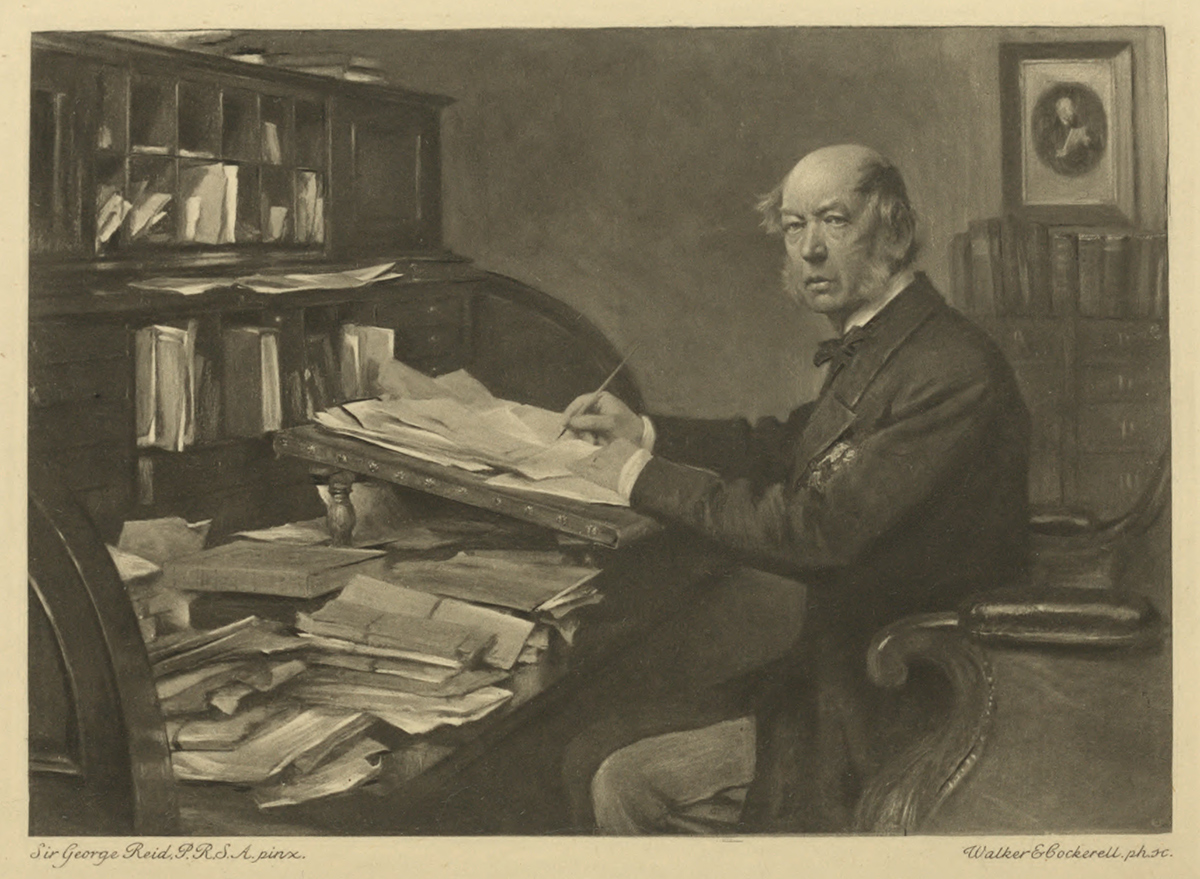
Portrait of John Murray. Illustration from John Murray IV, John Murray III, 1808-1892: A Brief Memoir (London: John Murray, 1919), frontispiece. Courtesy of the Internet Archive. John Murray III took an active interest in Missionary Travels and regularly corresponded with Livingstone throughout 1857 when the book was in preparation.
This edition, in contrast, enacts insights derived from book-historical approaches to the literature of exploration (MacLaren 1994, Finkelstein 2003, Keighren, Withers, and Bell 2015). In the presentation of the Missionary Travels manuscript, users will find interlinear additions, excised text, heavily rewritten passages, proof correction marks, and marginalia. By including such features in its editorial purview and by taking them to be integral to the document, this edition aspires to encourage future digital editions of major works of travel that give attention to material history.
Finally, the present edition might also be framed as a response to recent debates in the digital humanities about the “postcolonial archive.” Lately, some scholars have begun to criticise the existing digital Victorian archive for its relative disregard of imperial contexts and its tendency to privilege white European subjects (Koh 2014). Others, meanwhile, identify an “ethos of repair” in postcolonial digital collections, and argue for their capacity to creatively “augment or disrupt” the historical record while critiquing the imperial archives that preceded them (Ward and Wisnicki 2019). Such discussions are part of a developing interrogation of what has been called the “cultural politics of digitization” (Mussell 2014:383).
| (Left; top in mobile) Round a camp-fire. (Right; bottom) He caught my shoulder as he sprang. Illustrations from Basil Mathews, Livingstone the Pathfinder (New York: Missionary Education Movement of the United States and Canada, 1912), frontispiece, opposite 44. Courtesy of the Internet Archive. These images, which emphasise Livingstone's personal courage, are examples of a persistent tradition of iconography that casts explorers as individual heroes operating in hostile regions and that continues to inform present-day popular representations of exploration. By contrast, Livingstone Online's critical essays and editions – including the present edition of the Missionary Travels manuscript – seek to complicate this iconographic tradition by restoring nineteenth-century European travellers to a variety of complex cultural contexts in Europe and Africa. |
In focussing on a single-figure, one of Victorian Britain’s cherished heroes, a digital project such as Livingstone Online is of course open to challenge. In the wake of a long tradition of hagiography that has venerated Livingstone as an imperial icon, the site could be charged with implicitly perpetuating a history of “great men” at the expense of marginalised subjects. Livingstone Online, however, is well aware of such concerns. It responds in both its design and critical framework, not least by situating Livingstone in the “non-western environments” in which he travelled (Ward and Wisnicki 2016).
The present edition, therefore, complements and contributes to the site’s reflexive position. By approaching Missionary Travels through a pre-print working manuscript, the edition’s structure leads users to encounter the book in an unfamiliar way. It seeks to destabilise the seemingly “authoritative” nature of the published expeditionary narrative by highlighting the material and epistemic contexts and publication conditions that shaped one of the Victorian period’s most significant texts about Africa.
Conclusion Top ⤴
This edition develops Livingstone Online’s investigation into the inscriptive practices of the record of exploration by offering insight into the composition, correction, and revision of Livingstone’s most influential work. As the edition indicates more fully elsewhere, the Missionary Travels manuscript reveals distinctive patterns of literary redaction.
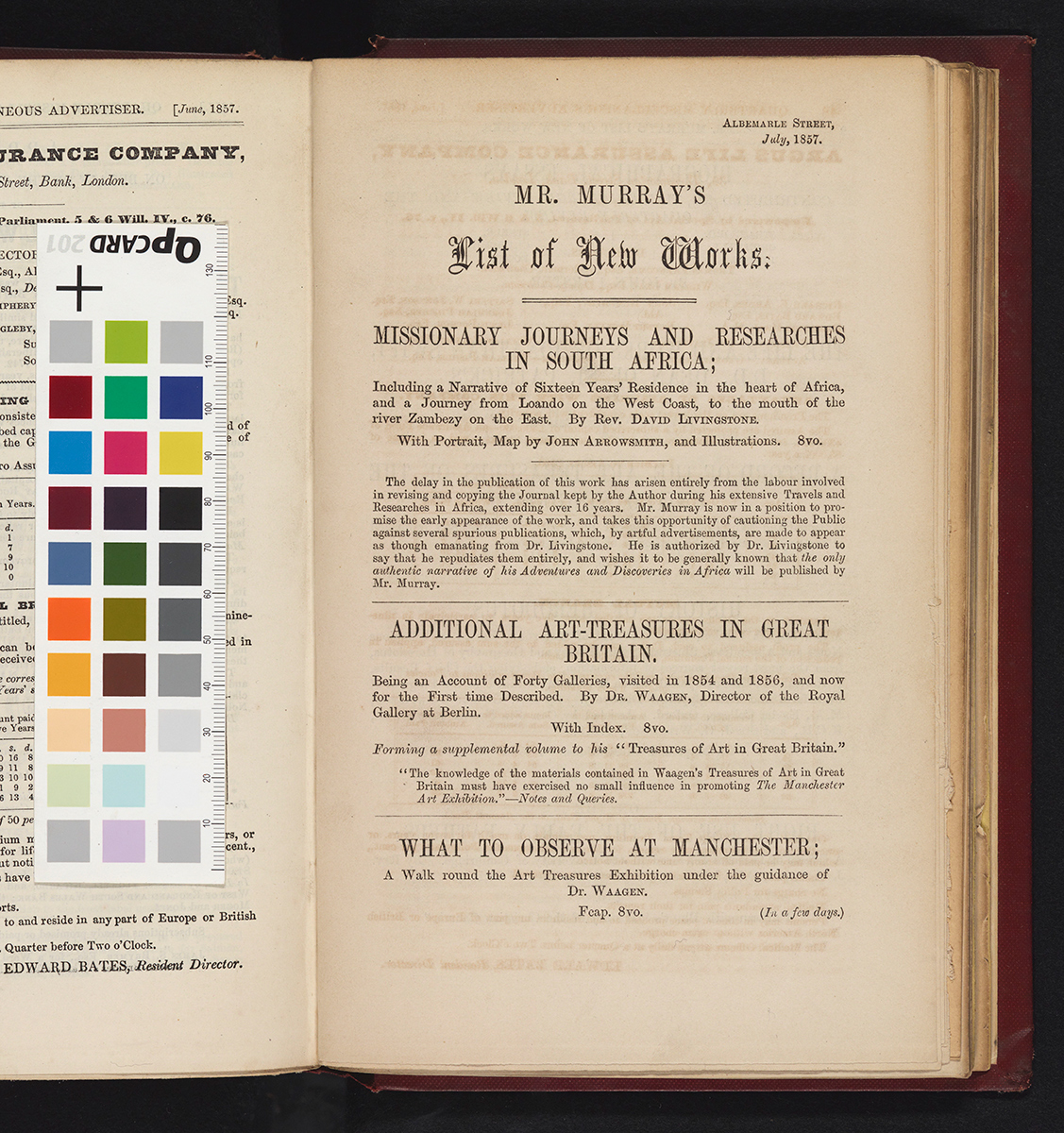
Trade Advert for Mr. Murray's List of New Works: Missionary Journeys and Researches in South Africa, Quarterly Review, 102 (July 1857-October 1857): July 1857, 1. Copyright National Library of Scotland. Creative Commons Share-alike 2.5 UK: Scotland. The advert above, which appeared four months before Missionary Travels was published, highlights some of the complexities involved in producing expeditionary narratives, including the ways that the process of editing could have effects beyond the immediate context of the final narrative. For instance, the advert reveals that the significant "labour involved in revising and copying the Journal kept by the Author during his extensive Travels and Researches in Africa" had in fact delayed the publication of the book, a statement that gains new meaning and depth when framed by the critical materials included in the present edition (for instance, see Composing and Publishing Missionary Travels [1] and Missionary Travels in Pen and Print [1]). The advert also shows that official travel narratives sometimes had to contend with competition from unauthorised accounts of expeditions released by rival publishers.
For instance, Livingstone’s book was shaped according to notions of politesse, filtered through protocols of etiquette at the hands of his publisher, John Murray. Perhaps more importantly, Missionary Travels was also subject to depoliticisation. Contentious political sentiments that might have impaired its success in the literary market were tempered or suppressed prior to public circulation.
With digital editing and publication, it is possible to track these editorial processes in considerable detail – to capture high and low levels of alteration, major acts of editing and minor interventions. In exposing the workings of author and publisher in the pages of the manuscript, this edition foregrounds the ways in which geographical and imperial knowledge were shaped for general consumption. Indeed, the edition shows the extent to which digital remediation and digital editing can extend critical investigations into the complex literary journey from manuscript to print.
Works Cited Top ⤴
Anon. n.d. Framed Photograph of Sechele, Chief of the BaKwena, Southern Africa. CWM/LMS/Home/Africa Pictures/10. School of Oriental and African Studies, London.
Bell, Bill. 2013. “Authors in an Industrial Economy: The Case of John Murray’s Travel Writers.” Romantic Textualities: Literature and Print Culture, 1780-1840 21: 9-29.
Bridges, Roy. 1987. “Nineteenth-Century East African Travel Records with an Appendix on ‘Armchair Geographers’ and Cartography.” Paideuma: Mitteilungen zur Kulturkunde 33: 179-96.
Bridges, Roy. 1998. “Explorers’ Texts and the Problems of Reactions by Non-Literate Peoples: Some Nineteenth-Century East African Examples.” Studies in Travel Writing 2 (1): 65-84.
Clendennen, Gary W., ed. 1992. David Livingstone’s Shire Journal, 1861-1864. Aberdeen: Scottish Cultural Press.
Clendennen, Gary W., ed. 1976. David Livingstone on the Zambezi: Letters to John Washington, 1861-1863. Pasadena: Munger Africana Library, California Institute of Technology.
Finkelstein, David. 2003. “Unraveling Speke: The Unknown Revision of an African Exploration Classic.” History in Africa 30: 117-32.
Fraistat, Neil, Raffaele Viglianti, and Elizabeth C. Delinger, eds. 2018. The Shelley-Godwin Archive. College Park, MD: Maryland Institute for Technology in the Humanities.
Fyfe, Paul. 2012. “Electronic Errata: Digital Publishing, Open Review, and the Futures of Correction.” In Debates in the Digital Humanities, edited by Matthew K. Gold. Minneapolis, MN: University of Minnesota Press.
Keighren, Innes M., Charles W. J. Withers, and Bill Bell. 2015. Travels into Print: Exploration, Writing, and Publishing with John Murray, 1773–1859. Chicago: University of Chicago Press.
Kichuk, Diana. 2007. “Metamorphosis: Remediation in Early English Books Online (EBBO).” Literary and Linguistic Computing 22 (3): 291-303.
Koh, Adeline. 2014. “Inspecting the Nineteenth-Century Literary Digital Archive: Omissions of Empire.” Journal of Victorian Culture 19 (3): 385-95.
MacLaren, I. S. 1994. “From Exploration to Publication: The Evolution of a 19th-century Arctic Narrative.” Arctic 47: 43-53
Maclaren, I. S. 2003. “Explorers’ and Travelers’ Narratives: A Peregrination through Different Editions.” History in Africa 30: 213-22.
Mayhew, Robert J. 2007. “Materialist Hermeneutics, Textuality and the History of Geography: Print Spaces in British Geography, c.1500-1900.” Journal of Historical Geography 33: 466-88.
Mussell, James. 2012. The Nineteenth-Century Press in the Digital Age. Basingstoke: Palgrave Macmillan.
Mussell, James. 2014. “The Postcolonial Archive.” Journal of Victorian Culture 19 (3): 383-84.
Pierazzo, Elena. 2014. “Digital Documentary Editions and the Others.” The Annual of the Association for Documentary Editing 35.
Price, Kenneth M. 2008. “Electronic Scholarly Editions.” In A Companion to Digital Literary Studies, edited by Susan Schreibman and Ray Siemens. Oxford: Blackwell.
Price, Kenneth M.. 2009. “Edition, Project, Database, Archive, Thematic Research Collection: What's in a Name?” Digital Humanities Quarterly 3 (3).
Schapera, Isaac, ed. 1959. David Livingstone Family Letters 1841-1856. 2 vols. London: Chatto & Windus.
Schapera, Isaac, ed. 1960a. Livingstone’s Private Journals 1851-1853. London: Chatto & Windus.
Schapera, Isaac, ed. 1961. Livingstone's Missionary Correspondence 1841-1856. London: Chatto & Windus.
Schapera, Isaac, ed. 1963. Livingstone’s African Journal, 1853-1856. 2 vols. London: Chatto & Windus.
Schapera, Isaac, ed. 1974. David Livingstone: South African Papers 1849-1853. Cape Town: Van Riebeeck Society.
Shepperson, George, ed. 1965. David Livingstone and the Rovuma: A Notebook. Edinburgh: Edinburgh University Press.
Sutherland, Kathryn, ed. 2010. Jane Austen’s Fiction Manuscripts: A Digital Edition. Oxford: University of Oxford; London: King's College London.
Sutherland, Kathryn. 2009. “Being Critical: Paper-based Editing and the Digital Environment.” In Text Editing, Print and the Digital World, edited by Marilyn Deegan and Kathryn Sutherland, 13-25. Farnham: Ashgate.
Thomas, Julia. 2010. “Digital Transformations.” Journal of Victorian Culture 13 (1): 101-07.
Ward, Megan, and Adrian S. Wisnicki. 2016. “The Theory Behind Livingstone Online.” First edition. In Livingstone Online: Illuminating Imperial Exploration, directed by Adrian S. Wisnicki, Megan Ward, Anne Martin, and Christopher Lawrence. New version, second edition. College Park, MD: University of Maryland Libraries.
Ward, Megan, and Adrian S. Wisnicki. 2019. “The Archive After Theory.” In Debates in the Digital Humanities, edited by Matthew K. Gold and Laura F. Klein, 200-05. Minneapolis; London: University of Minnesota Press.
Wisnicki, Adrian S. 2013. “Victorian Field Notes from the Lualaba River, Congo.” In “Livingstone Studies: Bicentenary Essays,” edited by Justin D. Livingstone, special issue. Scottish Geographical Journal 129 (3-4): 210-39.
Wisnicki, Adrian S. 2017. “Livingstone in 1871.” Updated version. In Livingstone’s 1871 Field Diary: A Multispectral Critical Edition, directed by Adrian S. Wisnicki. Updated version. In Livingstone Online: Illuminating Imperial Exploration, directed by Adrian S. Wisnicki, Megan Ward, Anne Martin, and Christopher Lawrence. New version, second edition. College Park, MD: University of Maryland Libraries.
Wisnicki, Adrian S., and Megan Ward, dirs. 2017. Livingstone’s 1870 Field Diary and Select 1870-1871 Manuscripts: A Multispectral Critical Edition. First edition. In Livingstone Online: Illuminating Imperial Exploration, directed by Adrian S. Wisnicki, Megan Ward, Anne Martin, and Christopher Lawrence. New version, second edition. College Park, MD: University of Maryland Libraries.
Withers, Charles W. J. and Innes M. Keighren. 2011. “Travels into Print: Authoring, Editing and Narratives of Travel and Exploration c.1815-1857.” Transactions of the Institute of British Geographers 36 (4): 560-73.


![John Murray III and Anon., David Livingstone - Boat Scene (Painted Magic Lantern Slide), [1857], detail. Copyright National Library of Scotland, CC BY-NC-SA 2.5 SCOTLAND. John Murray III and Anon., David Livingstone - Boat Scene (Painted Magic Lantern Slide), [1857], detail. Copyright National Library of Scotland, CC BY-NC-SA 2.5 SCOTLAND.](https://livingstoneonline.org:443/sites/default/files/section_page/carousel_images/liv_014067_0001-carousel.jpg)
![Image of two pages from Livingstone's Field Diary XVI (Livingstone 1872h:[2]-[3]). CC BY-NC 3.0 Image of two pages from Livingstone's Field Diary XVI (Livingstone 1872h:[2]-[3]). CC BY-NC 3.0](https://livingstoneonline.org:443/sites/default/files/section_page/carousel_images/liv_000016_0003-carousel.jpg)





![David Livingstone, Map of Lakes Nyassa and Shirwa [1864?], detail. Copyright National Library of Scotland, CC BY-NC-SA 2.5 SCOTLAND; Dr. Neil Imray Livingstone Wilson, CC BY-NC 3.0 David Livingstone, Map of Lakes Nyassa and Shirwa [1864?], detail. Copyright National Library of Scotland, CC BY-NC-SA 2.5 SCOTLAND; Dr. Neil Imray Livingstone Wilson, CC BY-NC 3.0](https://livingstoneonline.org:443/sites/default/files/section_page/carousel_images/liv_000077_0001-tile.jpg)


